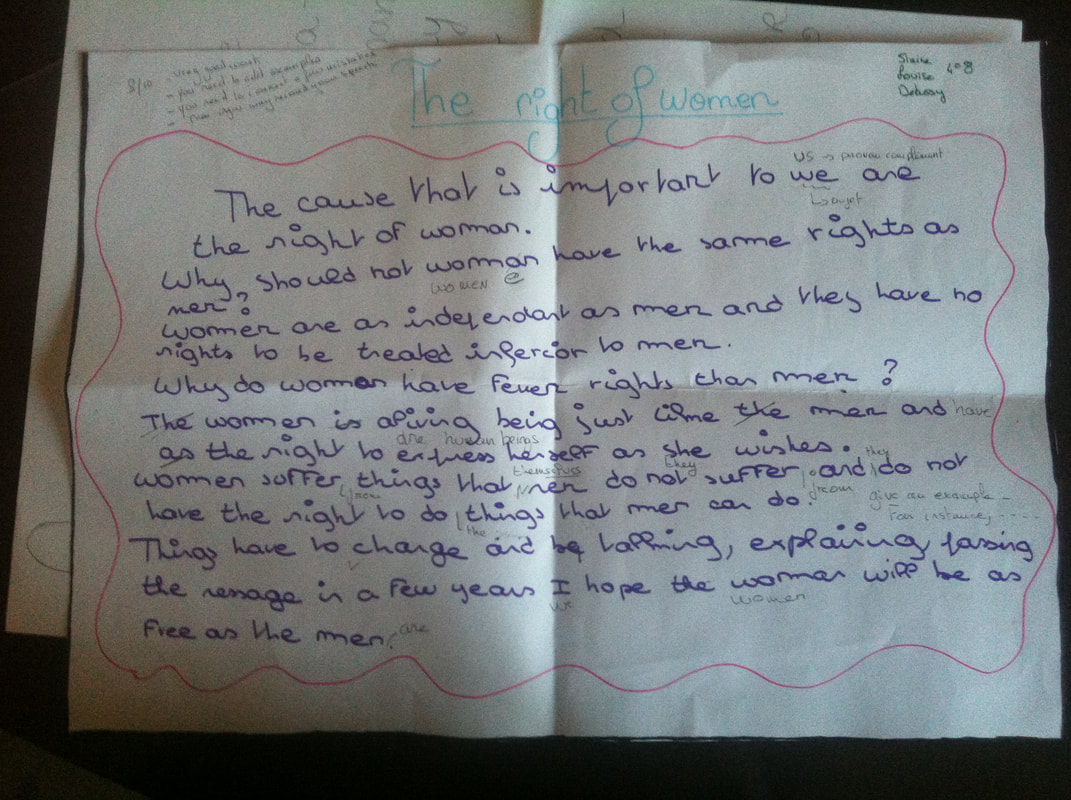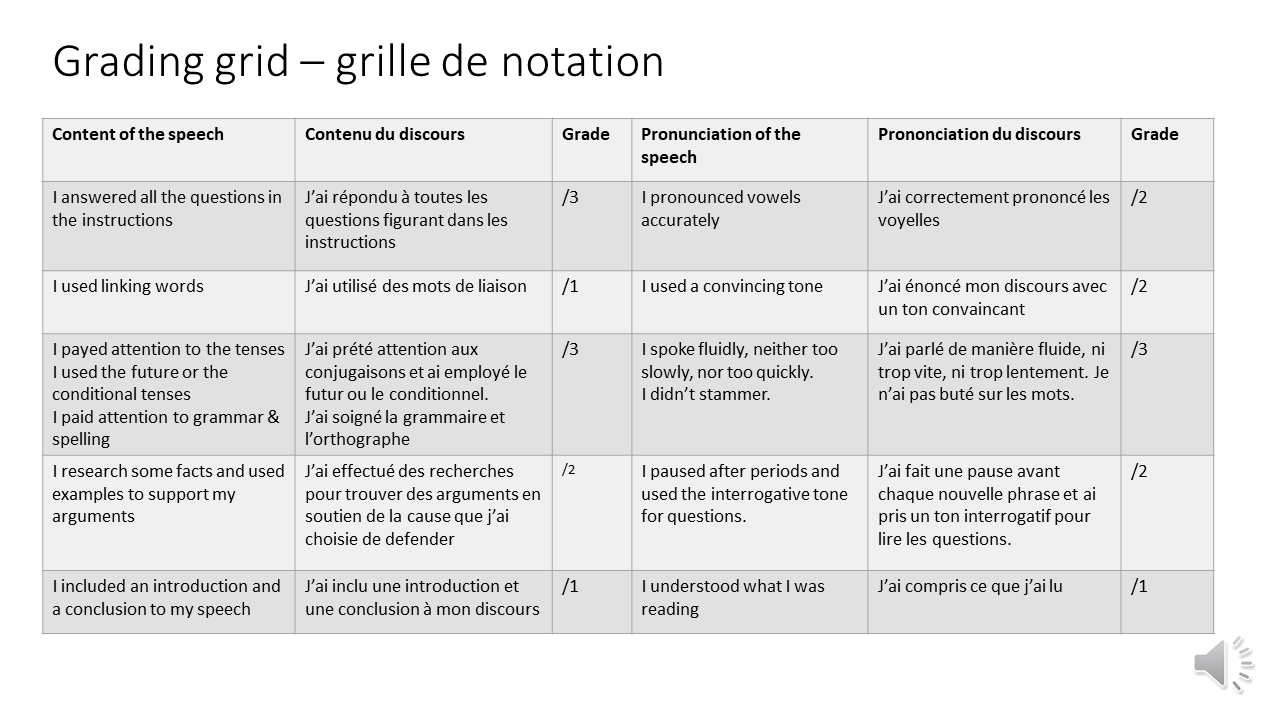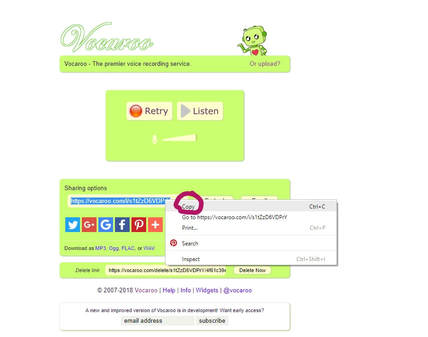Defend a cause | Speak out for a charity
|
Voici les instructions et consignes afin de terminer votre projet de discours dans le cadre de la séquence sur les associations caritatives.
Le projet final: -écrire un discours pour défendre une cause ou soutenir une association caritative, -envoyer le texte du discours pour correction (prenez une photo de votre travail ou tapez-le afin de me l'adresser par mail à [email protected] - réaliser un enregistrement vocal de la version corrigée du discours -envoyer l'enregistrement pour la note finale. (write a speech to defend a cause or to sponsor a charity organisation, send the text of the speech for correction, record the speech and send the recording). Partie écrite: Les élèves ont reçu des fiches sur le bénévolat et nous avons dédié deux séances à la découverte du vocabulaire propre à l'action humanitaire et aux problématiques sociales contemporaines. Nous nous sommes appuyés sur vos expérience lors de votre participation à la course contre la faim. La vidéo et la séquence récapitulent le vocabulaire et les points de grammaire nécessaires à la rédaction du discours. La date limite pour adresser le texte du discours (text due date) est le vendredi 9 février - Friday, February 9 Un exemple corrigé se trouve dans la séquence ci-jointe. Partie Orale: Dans la vidéo, je prononce le discours rédigé par des élèves avec le ton. Quelle note me donneriez-vous? Était-ce convainquant? Ai-je buté sur certains mots? Commencez à vous entraîner à prononcer le discours. Pour ce faire, dites-le à votre partenaire, enregistrez-vous et écoutez le résultat. Demandez à votre de partenaire de vous corriger. Lorsque vous êtes satisfait du résultat, vous pouvez générer un lien vers votre enregistrement et me l'envoyer par mail: [email protected] La date limite pour adresser le lien vers votre enregistrement audio est le 15 février. Attention, tous les élèves doivent fournir leur propre version du discours (chacun doit prononcer l'intégralité du discours). Pour vous enregistrer, vous pouvez utiliser votre smartphone ou un ordinateur équipé d'un micro. Vous devrez ensuite m'adresser l'enregistrement ou un lien vers l'enregistrement. Pour générer un lien vers un enregistrement (sans avoir à adresser le fichier lui-même) vous pouvez utiliser l'application vocaroo.com. Un tutoriel en français et en anglais figure à la fin de la vidéo (29:00) pour utiliser l'outil. |
La séquence contient:
Date limite pour adresser le texte du discours (text due date) : vendredi 9 février - Friday, February 9 Date limite pour adresser l’enregistrement du discours (recorded speech due date) : jeudi 15 février - Thursday, February 15 Good morning Students,
I will be absent for the next few days but you can still practice your English. So, let’s get started. (Alors, commencons) Do you remember what we were working on? What did we work on last time? That’s right. We were working on writing a speech to defend a cause or a charity. Let’s go over the instructions and the vocabulary once again to make sure everybody is up to speed. (Parcourons à nouveau les consignes et le vocabulaire afin que tout le monde puisse obtenir le même niveau de compréhension). |
writing and recording your speech: Instructions in english
So here are the instructions to write your speech
1/ Form groups 2/ Find a cause to defend (what cause will you defend?) 3/ Explain why this cause is important to you (Why do you want to help?) ex: I am fighting against animal cruelty. I want to raise awareness of this issue. According to _________, each year, ________ pets are abandoned by their owners. 4/ List the people who could benefit from your help (who will you help?) Ex: My help could benefit all kinds of animals, and especially abandoned pets. It could also benefit pet lovers who want to get a new pet. 5/ Explain how you will help (how will you help?) Ex 1: In the future, I will raise money/funds to build a shelter for mistreated or abandoned animals. Remember, you can help others by giving time or money. When you took part in the race against hunger you donated your time. Your sponsors contributed money. 6/ Gather your answers (rassembler vos réponses) to write a speech to defend your cause and inspire people to join your fight |
écrire et enregistrer votre discours: résumé des consignes en français
Texte du résumé des consignes en français:
Trouvez une cause que vous souhaitez défendre. Une fois que vous avez trouvé une cause à défendre, expliquez les raisons de votre choix, indiquez quelles sont les personnes que vous aiderez et la manière dont vous envisagez de défendre la cause que vous avez choisie. En rassemblant les réponses à chacune des questions vous obtiendrez la trame de votre discours (speech). Prenez une photo de votre travail et envoyez-là à [email protected] en prenant soin d'indiquer votre nom et votre classe. Je corrigerai ensuite votre travail et vous renverrai des commentaires écrits. Vous trouverez un exemple déjà corrigé ci-dessous. Vous pourrez ensuite enregistrer votre discours sur votre smartphone ou en utilisant l'application vocaroo.com. Consultez le tutoriel ci-dessous pour transmettre votre enregistrement. Je corrigerai ensuite votre discours et vous attribuerai une note finale (écrit/oral). Bien que le travail écrit soit réalisé en groupe, chaque élève doit envoyer son propre enregistrement, sa propre version du discours. |
Tools to write your speech - outils pour écrire votre discours
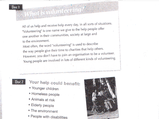
Use the documents handed out in class about volunteering. The document is also on pronote.
Use the vocabulary discovered in class, which you can also find below.
Use a dictionary. Ask permission to use those located in Classroom 117 ( if your are a student at Le Corbusier)
Review the grammar lesson and the vocabulary below.
Use the vocabulary discovered in class, which you can also find below.
Use a dictionary. Ask permission to use those located in Classroom 117 ( if your are a student at Le Corbusier)
Review the grammar lesson and the vocabulary below.
grammar recap
To write your speech, you can use the future (will + b.v) or the conditional (would + b.v)
b.v. = base verbale (l'infinitif du verbe sans le "to").
Cet exercice vous permet d'utiliser le modal "will" avec la base verbale pour indiquer l'engagement futur.
Vous pouvez également utilisez le modal "would" et a base verbale si vous souhaitez employer le conditionnel.
Rappel de la différence entre le futur (will+ bv) et le conditionnel (would + bv):
le futur: Will + base verbale
Who will you help? se traduit par "qui aiderez-vous?" Il s'agit du futur.
Ex: In the future, I will help Elderly people. Dans le futur, j'aiderai les personnes âgées.
Je ne peux pas t'aider aujourd'hui mais je t'aiderai (sans S) demain. -> I will help you tomorrow. Il s'agit du futur du verbe aider (je m'y engage et ne pose aucune condition).
Le conditionnel: would + base verbale
Si vous souhaitez employer le conditionnel "qui aideriez-vous (si vous le pouviez)?", il faut alors employer le modal "would" et la base verbale
-> Who would you help (if you could)?
b.v. = base verbale (l'infinitif du verbe sans le "to").
Cet exercice vous permet d'utiliser le modal "will" avec la base verbale pour indiquer l'engagement futur.
Vous pouvez également utilisez le modal "would" et a base verbale si vous souhaitez employer le conditionnel.
Rappel de la différence entre le futur (will+ bv) et le conditionnel (would + bv):
le futur: Will + base verbale
Who will you help? se traduit par "qui aiderez-vous?" Il s'agit du futur.
Ex: In the future, I will help Elderly people. Dans le futur, j'aiderai les personnes âgées.
Je ne peux pas t'aider aujourd'hui mais je t'aiderai (sans S) demain. -> I will help you tomorrow. Il s'agit du futur du verbe aider (je m'y engage et ne pose aucune condition).
Le conditionnel: would + base verbale
Si vous souhaitez employer le conditionnel "qui aideriez-vous (si vous le pouviez)?", il faut alors employer le modal "would" et la base verbale
-> Who would you help (if you could)?
- I would help pandas if I could. (J'aiderais les pandas, si je le pouvais)
- I would like to help: j'aimerais aider (il s'agit du conditionnel du verbe "to like")
- J'aiderais (si je le pouvais) -> I would help (if I could). Il s'agit du conditionnel du verbe "aider" (je ne m'engage à rien, je précise juste que, si j'en avais la possibilité, j'apporterais mon aide).
vocabulary
vocabulary : volunteering - defending a cause
Ne confondez pas "to fight" (combattre) et "to beat" (battre). (to beat - beat - beaten)
ex: Raphaël beat Paul at Tennis last week. PSG beat Dijon two weeks ago. Spiderman fights evil.
ex: Raphaël beat Paul at Tennis last week. PSG beat Dijon two weeks ago. Spiderman fights evil.
- to give: donner
- to fight for: se battre pour/lutter pour
- to fight against: se battre contre
- again: encore
- to fight with: se battre avec
- against: contre
- to contribute: contribuer à/ faire une donation
- to donate: faire une donation /donner de l'argent
- benefit: profiter à
- hope: espoir/ to hope: espérer
- help: aider
- take part in: participer à / prendre part à
- to find: trouver
- to deserve: mériter
- a serious issue: un problème grave
- to suffer from: subir (de mauvais traitements)
- to stay: rester
- alive: vivant
- to live: vivre/habiter
- to leave: quitter/partir
vocabulary related to animal at risks
- mistreated animals: les animaux maltraités
- animal cruelty: la cruauté envers les animaux
- abandonned pets: les animaux de compagnie abandonnés
- animal shelter: refuge animalier
vocabulary related to women's rights
- domestic violence: violence conjugale
- one woman/ two women (one man/ two men)
- gender equality: égalité entre les sexe (homme/femme)
- gender: le genre (masculin/féminin)
- human-beings: les êtres-humains
- equal pay/ equal wages: égalité salarial
- inégalité salariale: wages inequality
- low income: revenus faibles
vocabulary related to discriminations
employment: l'emploi
unemployment: le chômage
a job: un travail
sans travail: jobless
sans maison/ sans domicile: homeless
a house: une maison
to house: héberger
housing: hébergement/logement
unemployment: le chômage
a job: un travail
sans travail: jobless
sans maison/ sans domicile: homeless
a house: une maison
to house: héberger
housing: hébergement/logement
vocabulary related to child hunger
hunger: la faim
to starve: mourir de faim
thin: mince
skinny: maigre
nutritious
to starve: mourir de faim
thin: mince
skinny: maigre
nutritious
vocabulary related to the environment
global warming: le réchauffement climatique
waste: le gachis/ les déchets
chemical/toxical waste: les déchets toxiques
recycling: le recyclage
waste: le gachis/ les déchets
chemical/toxical waste: les déchets toxiques
recycling: le recyclage
vocabulary related to bullying- harassment
- a bully: celui qui harcèle (nom)
- to bully: harceler (verbe)
bullying: le harcèlement (nom + gérondif: le fait de harceler) - bullied (kid): (enfant harcelé) (participe passé utilisé en tant qu'adjectif)
Tools and tutorials to send your text work and your recording
Here are the instructions to send your written work and the instructions to record your speech and send it to your teacher.
1/ Send a clear picture of the text of your speech to the following address:
[email protected]
2/ Record your speech. You may try as many times as you like. Your speech must last at least 1:00 minutes and not more than 2 minutes.
3/ Read the tutorial to record your speech then upload your recording onto the application vocaroo.com.
4/ Send the link of your recording to this email address:
[email protected]
1/ Send a clear picture of the text of your speech to the following address:
[email protected]
2/ Record your speech. You may try as many times as you like. Your speech must last at least 1:00 minutes and not more than 2 minutes.
3/ Read the tutorial to record your speech then upload your recording onto the application vocaroo.com.
4/ Send the link of your recording to this email address:
[email protected]
tools to send the text of your speech - outils pour envoyer le texte de votre discours
Indicate the name of each group members and your class and college.
Take a clear picture of your speech and send it to the following email address:
[email protected]
Take a clear picture of your speech and send it to the following email address:
[email protected]
Here is a very good example, together with the correction and comments in red.
|
Women's right
(les femmes étant une catégorie générale, il n'est pas nécesaire d'employer "the", mais simplement le féminin de "woman", c'est à dire "women".) The cause that is important to us is the fight for women's right. (Il y a une seule cause, il faut donc employer la troisième personne du singulier). (we: pronom sujet / us: pronom complément) Why should not women have the same rights as men do? Women should be as independant as men are. Men should not have the right to treat women as an inferior minority. Why do women have fewer rights than men? Men and women are human-beings. As such they should be treated equally. Women should have the right to express themselves as they wish. (herself -> elle-même au singulier/ themselves: elles-même ou eux-même au pluriel) Women suffer from things that men do not have to endure. In some countries, women do not have the right to do some of the things that men can do. Things have to change and by talking, explaining, passing on the message, we hope that in a few years women will actually be as free as men are. Sirine et louise ont répondu à toutes les questions
|
tools to record your speech and send it to your teacher - outils pour envoyer l'enregistrement de votre discours
Record your speech on your smartphone or using a computer and a microphone.
Upload your recording onto vocaroo.com.
Follow the tutorial below if you choose to record your speech with vocaroo.
Upload your recording onto vocaroo.com.
Follow the tutorial below if you choose to record your speech with vocaroo.
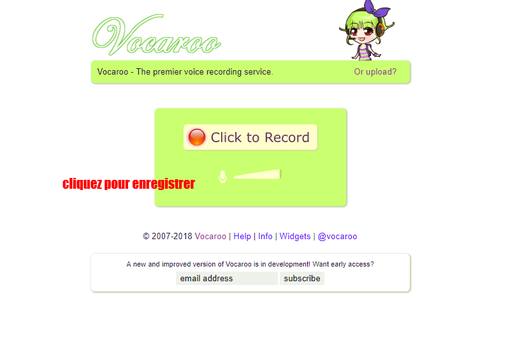
Step 1: Go to vocaroo.com;
Click on the red button to start recording.
Etape 1: Allez sur le site "vocaroo.com".
Cliquez sur le boutton rouge pour débuter l'enregistrement.
Click on the red button to start recording.
Etape 1: Allez sur le site "vocaroo.com".
Cliquez sur le boutton rouge pour débuter l'enregistrement.
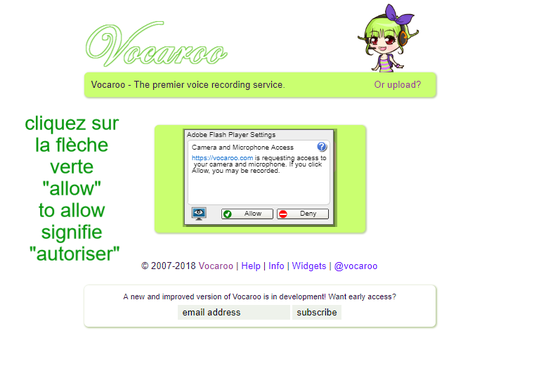
Step 2: click on the green arrow to authorize recording.
Étape 2: cliquez sur la flèche verte "allow" pour autoriser l'application à vous enregistrer.
Étape 2: cliquez sur la flèche verte "allow" pour autoriser l'application à vous enregistrer.
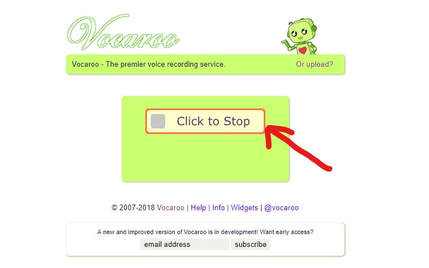
Step 3: Click to stop your recording when your are finished talking.
Etape 3: Cliquez sur "click to stop" pour arrêter l'enregistrement.
Etape 3: Cliquez sur "click to stop" pour arrêter l'enregistrement.
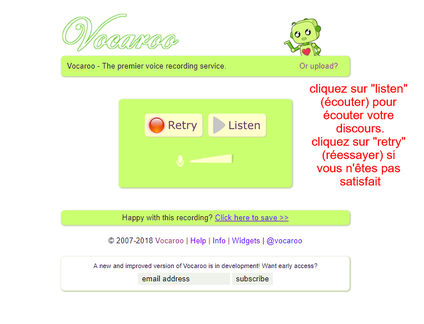
Step 4: Listen to your recording. Try again if you are not satisfied with it.
When you are satisfied with your recording, click on "click here to save".
Etape 4: Ecoutez votre enregistrement. Recommencez si vous n'êtes pas satisfait du résultat.
When you are satisfied with your recording, click on "click here to save".
Etape 4: Ecoutez votre enregistrement. Recommencez si vous n'êtes pas satisfait du résultat.
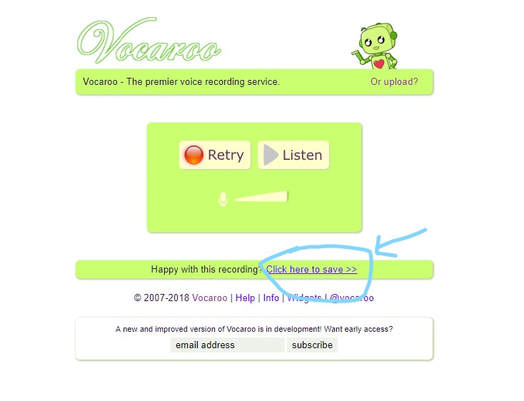
Step 5: If you are satisfied with your work, you may send it by clicking on "click here to save" (circled in blue below)
Si vous êtes satisfait de votre travail, vous pouvez générer un lien en cliquant sur "click here to save" (cliquez ici pour sauvegarder)
Si vous êtes satisfait de votre travail, vous pouvez générer un lien en cliquant sur "click here to save" (cliquez ici pour sauvegarder)
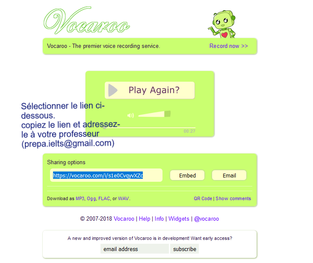
Step 5: select the link generated by the app. Copy the link and send it to this email address:
Etape 5: sélectionnez le lien généré par l'outil. Copiez le lien dans un email et adressez-le à l'adresse mail suivante: [email protected] |
